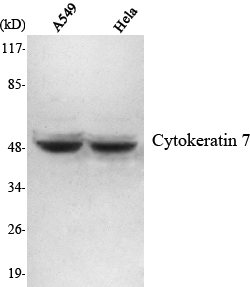Cytokeratin 7 Monoclonal Antibody
- Catalog No.:YM1027
- Applications:WB;IF
- Reactivity:Human;Mouse;Rat;Bovine
- Target:
- Cytokeratin 7
- Gene Name:
- KRT7
- Protein Name:
- Keratin type II cytoskeletal 7
- Human Gene Id:
- 3855
- Human Swiss Prot No:
- P08729
- Mouse Gene Id:
- 110310
- Mouse Swiss Prot No:
- Q9DCV7
- Rat Gene Id:
- 300242
- Rat Swiss Prot No:
- Q6IG12
- Immunogen:
- Purified recombinant human Cytokeratin 7 (N-terminus) protein fragments expressed in E.coli.
- Specificity:
- Cytokeratin 7 Monoclonal Antibody detects endogenous levels of Cytokeratin 7 protein.
- Formulation:
- Liquid in PBS containing 50% glycerol, 0.5% BSA and 0.02% sodium azide.
- Source:
- Monoclonal, Mouse
- Dilution:
- WB 1:1000 - 1:2000. IF 1:100 - 1:500. Not yet tested in other applications.
- Purification:
- Affinity purification
- Concentration:
- 1 mg/ml
- Storage Stability:
- -15°C to -25°C/1 year(Do not lower than -25°C)
- Other Name:
- KRT7;SCL;Keratin; type II cytoskeletal 7;Cytokeratin-7;CK-7;Keratin-7;K7;Sarcolectin;Type-II keratin Kb7
- Molecular Weight(Da):
- 51kD
- Background:
- keratin 7(KRT7) Homo sapiens The protein encoded by this gene is a member of the keratin gene family. The type II cytokeratins consist of basic or neutral proteins which are arranged in pairs of heterotypic keratin chains coexpressed during differentiation of simple and stratified epithelial tissues. This type II cytokeratin is specifically expressed in the simple epithelia lining the cavities of the internal organs and in the gland ducts and blood vessels. The genes encoding the type II cytokeratins are clustered in a region of chromosome 12q12-q13. Alternative splicing may result in several transcript variants; however, not all variants have been fully described. [provided by RefSeq, Jul 2008],
- Function:
- function:Blocks interferon-dependent interphase and stimulates DNA synthesis in cells. Involved in the translational regulation of the human papillomavirus type 16 E7 mRNA (HPV16 E7).,induction:Up-regulated by retinoic acid.,mass spectrometry: PubMed:11840567,miscellaneous:There are two types of cytoskeletal and microfibrillar keratin: I (acidic; 40-55 kDa) and II (neutral to basic; 56-70 kDa).,PTM:Arg-20 is dimethylated, probably to asymmetric dimethylarginine.,similarity:Belongs to the intermediate filament family.,subunit:Heterotetramer of two type I and two type II keratins. Interacts with eukaryotic translation initiator factor 3 (eIF3) subunit EIF3S10 and with HPV16 E7.,tissue specificity:Expressed in cultured epidermal, bronchial and mesothelial cells but absent in colon, ectocervix and liver. Observed throughout the glandular cells in the junction between stomach and esophagus bu
- Subcellular Location:
- Cytoplasm .
- Expression:
- Expressed in cultured epidermal, bronchial and mesothelial cells but absent in colon, ectocervix and liver. Observed throughout the glandular cells in the junction between stomach and esophagus but is absent in the esophagus.
Immortalized bovine mammary epithelial cells express stem cell markers and differentiate in vitro. CELL BIOLOGY INTERNATIONAL 2016 Jun 19 ICC Human MCF-7 cell
- June 19-2018
- WESTERN IMMUNOBLOTTING PROTOCOL
- June 19-2018
- IMMUNOHISTOCHEMISTRY-PARAFFIN PROTOCOL
- June 19-2018
- IMMUNOFLUORESCENCE PROTOCOL
- September 08-2020
- FLOW-CYTOMEYRT-PROTOCOL
- May 20-2022
- Cell-Based ELISA│解您多样本WB检测之困扰
- July 13-2018
- CELL-BASED-ELISA-PROTOCOL-FOR-ACETYL-PROTEIN
- July 13-2018
- CELL-BASED-ELISA-PROTOCOL-FOR-PHOSPHO-PROTEIN
- July 13-2018
- Antibody-FAQs
- Products Images

- Western Blot analysis using Cytokeratin 7 Monoclonal Antibody against A459, HeLa cell lysate.

- Immunofluorescence analysis of HeLa cells using Cytokeratin 7 Monoclonal Antibody.



